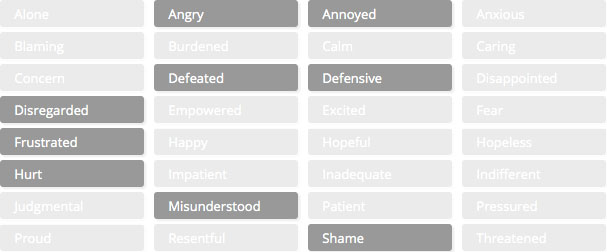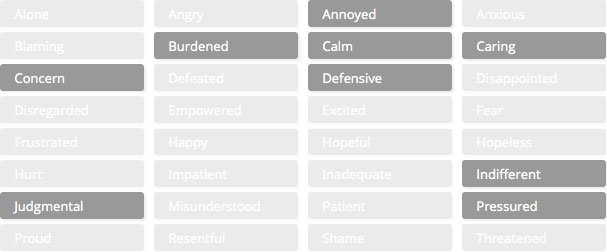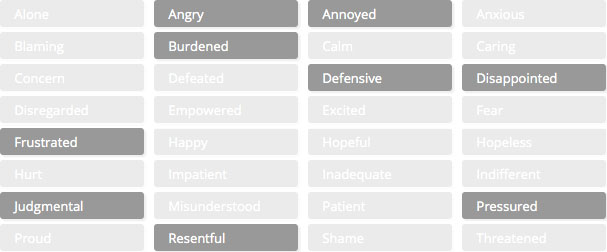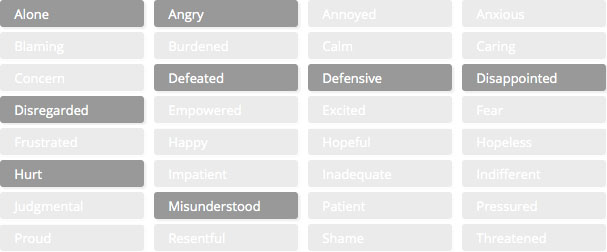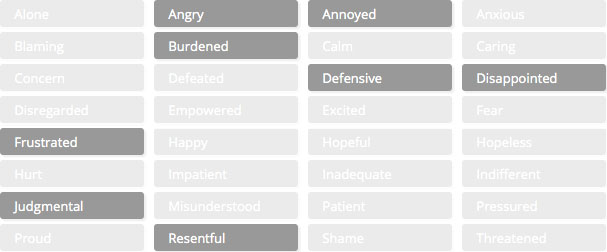Bagging Groceries EmQ®
The purpose of discovering your EmQ score is to help you improve your natural ability to recognize and accurately assess the thoughts and feelings of others and understand how to build a foundation for happier, healthier more productive relationships.
Try again to improve your EmQ by using the Helpful Hints and Coaching Notes provided for each of the questions below.
These are only your lowest-scoring questions and answers. (Your high-scoring questions have been saved and will be added to your new scores below.)
Bagging Groceries teaches as you go. You will be asked to watch video segments and then answer questions about what you observed in the couple’s dynamic.
When you have completed the quiz, you will have the opportunity to redo your lowest scoring questions with the support of some thought-provoking helpful hints, and coaching notes. We hope you will take this opportunity to explore more and dig deeper into the empathic attunement process.
Welcome to EmpathyWorks!
Thank you for participating in our multi-faceted research study. When you sign-in please be sure to indicate if you are participating in Phase 1 or Phase 2.
PHASE 1
Determines the internal equivalency of the EmQ Empathy Quotient, a non-self-reporting method for measuring empathic ability. (You have not taken the Empathy Training.)
PHASE 2
Determines the efficacy of the Empathy Training Program.
We are very grateful for your time!
Quiz-summary
0 of 29 questions completed
Questions:
- 1
- 2
- 3
- 4
- 5
- 6
- 7
- 8
- 9
- 10
- 11
- 12
- 13
- 14
- 15
- 16
- 17
- 18
- 19
- 20
- 21
- 22
- 23
- 24
- 25
- 26
- 27
- 28
- 29
Information
Full Video
Please review this video before proceeding to the first question.
|
You must specify a text. |
|
|
You must specify an email address. |
|
|
You must fill out this field. |
|
|
You must fill out this field. |
|
|
You must fill out this field. |
|
|
You must fill out this field. |
|
|
You must fill out this field. |
|
|
You must fill out this field. |
|
|
You must fill out this field. |
You have already completed the quiz before. Hence you can not start it again.
Quiz is loading...
You must sign in or sign up to start the quiz.
You have to finish following quiz, to start this quiz:
Results
Time has elapsed
Categories
- Not categorized 0%
- 1
- 2
- 3
- 4
- 5
- 6
- 7
- 8
- 9
- 10
- 11
- 12
- 13
- 14
- 15
- 16
- 17
- 18
- 19
- 20
- 21
- 22
- 23
- 24
- 25
- 26
- 27
- 28
- 29
- Answered
- Review
-
Question 1 of 29
1. Question
Video Segment #1
Please view this video before proceeding to the first question.
Helpful Hint (Question #1)
Did you put yourself in Tom’s shoes and consider what he was feeling in the store? He says he’s “annoyed,” but what else might he be feeling and not openly expressing? Are you identifying with Tom, or with the grocery clerk? Are you judging his need for separate bags?
EXPERT STATS
- The feelings the experts didn’t pick have been faded out.
- Of the remaining 9 feelings, 97% of the experts agreed on 3 dominant feelings.
- Try again and answer the question below to see if you can select the same three feelings as the experts.
Coaching Note (Question #1)
When tuning into someone’s inner experience, listen for context more than content, listen for their feelings and try not to focus just on facts. While facts can be helpful, try to assess what’s going on emotionally.Then ask yourself why they might be feeling this way? This can be difficult, because often feelings experienced in-the-moment are not clearly expressed, and can be related to some past event or interaction.
It’s also important to be aware of your own feelings, especially any judgments or biases that may make it difficult to see the other person’s point of view.
1. Tom’s Feeling
At this point in the vignette, what do you think is Tom’s dominant feeling?
Choose 3 feelings (1st, 2nd, 3rd choice).Sort elements
- Alone
- Angry
- Annoyed
- Anxious
- Blaming
- Burdened
- Calm
- Caring
- Concern
- Defeated
- Defensive
- Disappointed
- Disregarded
- Empowered
- Excited
- Fear
- Frustrated
- Happy
- Hopeful
- Hopeless
- Hurt
- Impatient
- Inadequate
- Indifferent
- Judgmental
- Misunderstood
- Patient
- Pressured
- Proud
- Resentful
- Shame
- Threatened
-
Dominant Feeling
-
Secondary Feeling
-
Third Feeling
-
Question 2 of 29
2. Question
Helpful Hint (Question #2)
Though Tom says he is “annoyed,” did you consider that he might be feeling shame and humiliation about how he was treated at the store? Do you think he may be downplaying his upset because he is uncomfortable sharing those vulnerable feelings with Jane?
Coaching Note (Question #2)
It’s not always easy to be aware of the strength of a feeling, or to when a feeling is intensifying or diminishing. But, this is valuable information about the other’s inner experience, because often we react more to the strength of a feeling than to the feeling itself. It affects our ability to respond appropriately, and not just react unconsciously. Learn to listen for the strength of feelings.
2. Strength of Tom’s Feeling
Based on your previous answer, how would you gauge the general strength of Tom’s dominant feeling? Please rate on a scale of 1-5.
-
Question 3 of 29
3. Question
Helpful Hint (Question #3)
What clues help you understand what Tom is feeling—feelings that he may, or may not be aware of?
Coaching Note (Question #3)
This is a tough question because feelings are communicated by all four: words, intonation, facial expression & body language. Do you tend to be more affected by visual or verbal communication? Try to become more aware of your natural tendency, and be sure to listen with both your eyes and ears.
3. Tom’s Assessment
What most informs your assessment of Tom’s feelings? Select 1.
-
Question 4 of 29
4. Question
Helpful Hint (Question #4)
Jane seems cheerful, happy and occupied with her computer when Tom comes home. While she appears not to be disturbed, did you notice that Tom interrupted her? When she asks him how it went, do you think she is really interested in his upset?
EXPERT STATS
- The feelings the experts didn’t pick have been faded out.
- Of the remaining 9 feelings, 57% of the experts agreed on 3 dominant feelings.
- Try again and answer the question below to see if you can select the same three feelings as the experts.
Coaching Note (Question #4)
When tuning into someone’s inner experience, listen for context more than content, listen for their feelings and try not to focus just on facts. While facts can be helpful, try to assess what’s going on emotionally.Then ask yourself why they might be feeling this way? This can be difficult, because often feelings experienced in-the-moment are not clearly expressed, and can be related to some past event or interaction.
It’s also important to be aware of your own feelings, especially any judgments or biases that may make it difficult to see the other person’s point of view.
4. Jane’s Feeling
At this point in the vignette, what do you think is Jane’s dominant feeling?
Choose 3 feelings (1st, 2nd, 3rd choice).Sort elements
- Alone
- Angry
- Annoyed
- Anxious
- Blaming
- Burdened
- Calm
- Caring
- Concern
- Defeated
- Defensive
- Disappointed
- Disregarded
- Empowered
- Excited
- Fear
- Frustrated
- Happy
- Hopeful
- Hopeless
- Hurt
- Impatient
- Inadequate
- Indifferent
- Judgmental
- Misunderstood
- Patient
- Pressured
- Proud
- Resentful
- Shame
- Threatened
-
Dominant Feeling
-
Secondary Feeling
-
Third Feeling
-
Question 5 of 29
5. Question
Helpful Hint (Question #5)
Tough to gauge how strongly Jane is feeling at this point because you don’t know her, but, do you think she may be downplaying Tom’s upset in an effort to minimize and manage her own?
Coaching Note (Question #5)
It’s not always easy to be aware of the strength of a feeling, or to when a feeling is intensifying or diminishing. But, this is valuable information about the other’s inner experience, because often we react more to the strength of a feeling than to the feeling itself. Learn to listen for the strength of feelings.
5. Strength of Jane’s Feeling
Based on your previous answer, how would you gauge the general strength of Jane’s dominant feeling? Please rate on a scale of 1-5.
-
Question 6 of 29
6. Question
Helpful Hint (Question #6)
Listen with both your eyes and ears. Watch for body language, sometimes it will tell you something more (or different) than the words being spoken.
Coaching Note (Question #6)
This is a tough question because feelings are communicated by all four: words, intonation, facial expression & body language. Do you tend to be more affected by visual or verbal communication? Try to become more aware of your natural tendency, and be sure to listen with both your eyes and ears.
6. Jane’s Assessment
What most informs your assessment of Jane’s feelings? Select 1.
-
Question 7 of 29
7. Question
Helpful Hint (Question #7)
When Tom came home from the store, did you take into consideration his vulnerable feelings? Imagine how he hoped Jane would respond when he shared his upset with her. What might that hope imply about what he needs from her?
Coaching Note (Question #7)
It is difficult to get in touch with our emotional needs, and as a result they often go unexpressed and unmet. Emotional needs (met or unmet) are very important because they impact our feelings and behavior. Can you tune into the need that may be behind a person’s behavior. Ask yourself… “What does that behavior need/want?”
If you would like to review the same video again, please watch it now. If you do not want to review the video you may proceed to the next question.
7. Mutual Need
At this point in the vignette, do you have a sense of what Tom needs from Jane?
Choose three needs (1 Strongest/3 Weakest).Sort elements
- Nothing
- Left Alone
- For her to align with his perspective
- To be seen/heard/understood
- Attention
- His need to prevail
- Can't determine
- To be taken care of
-
Strongest Need
-
Secondary Need
-
Weakest Need
-
Question 8 of 29
8. Question
Helpful Hint (Question #8)
Consider how Jane was focused on her work when Tom came home. Now she is being asked to focus on Tom’s upset. How do you think that feels to Jane, and what might she need, or want instead?
Coaching Note (Question #8)
It is difficult to get in touch with our emotional needs, and as a result they often go unexpressed and unmet. Emotional needs (met or unmet) are very important because they impact our feelings and behavior. Can you tune into the need that may be behind a person’s behavior. Ask yourself… “What does that behavior need/want?”
8. Mutual Need
At this point in the vignette, do you have a sense of what Jane needs from Tom?
Choose three needs (1 strongest/3 Weakest).Sort elements
- Nothing
- Left Alone
- For him to align with her perspective
- To be seen/heard/understood
- Attention
- Her need to prevail
- Can't determine
- To be taken care of
-
Strongest Need
-
Secondary Need
-
Weakest Need
-
Question 9 of 29
9. Question
Helpful Hint (Question #9)
Do you think Tom is aware of how he interrupted Jane and what she needs from him? How do you think that feels to Jane?
Coaching Note (Question #9)
In relationships we are impacting each other nearly every moment—this mutual impact dynamic is a constantly evolving co-creation. It is very important to be aware of how we impact others and how they impact us. Otherwise, unconscious reactions and responses can lead to misunderstanding and upset.
9. Mutual Impact
At this point is the vignette, how is Tom impacting Jane?
Select 1. -
Question 10 of 29
10. Question
Helpful Hint (Question #10)
Observe how Tom & Jane are responding to each other. Are they moving closer together or further apart? How much?
Coaching Note (Question #10)
It’s important to be aware of how our feelings affect our behavior, and to what degree our behavior is impacting others. Observe how others respond to you, and how much their feelings shift during your interaction.
10. Mutual Impact
To what degree is Tom impacting Jane? Please rate on a scale 1-5.
-
Question 11 of 29
11. Question
Video Segment #2
Please view this video before proceeding to the next question.
Helpful Hint (Question #11)
A clue to Jane’s feelings can be seen in her reactions and responses, which seem more identified with the store clerk than with Tom. Putting yourself in Jane’s shoes, how do you think she feels about Tom’s need to share his upset at the store?
EXPERT STATS
- The feelings the experts didn’t pick have been faded out.
- Of the remaining 9 feelings, 57% of the experts agreed on 3 dominant feelings.
- Try again and answer the question below to see if you can select the same three feelings as the experts.
Coaching Note (Question #11)
When tuning into someone’s inner experience, listen for context more than content, listen for their feelings and try not to focus just on facts. While facts can be helpful, try to assess what’s going on emotionally.Then ask yourself why they might be feeling this way? This can be difficult, because often feelings experienced in-the-moment are not clearly expressed, and can be related to some past event or interaction.
It’s also important to be aware of your own feelings, especially any judgments or biases that may make it difficult to see the other person’s point of view.
11. Jane’s Feeling
At this point in the vignette, what do you think is Jane’s dominant feeling?
Choose 3 feelings (1st, 2nd, 3rd choice).Sort elements
- Alone
- Angry
- Annoyed
- Anxious
- Blaming
- Burdened
- Calm
- Caring
- Concern
- Defeated
- Defensive
- Disappointed
- Disregarded
- Empowered
- Excited
- Fear
- Frustrated
- Happy
- Hopeful
- Hopeless
- Hurt
- Impatient
- Inadequate
- Indifferent
- Judgmental
- Misunderstood
- Patient
- Pressured
- Proud
- Resentful
- Shame
- Threatened
-
Dominant Feeling
-
Secondary Feeling
-
Third Feeling
-
Question 12 of 29
12. Question
Helpful Hint (Question #12)
As Tom continues to need Jane’s attention and understanding about his upset, observe Jane’s responses and behavior for a clue to the strength of her feeling.
Coaching Note (Question #12)
It’s not always easy to be aware of the strength of a feeling, or to when a feeling is intensifying or diminishing. But, this is valuable information about the other’s inner experience, because often we react more to the strength of a feeling than to the feeling itself. Learn to listen for the strength of feelings.
12. Strength of Jane’s Feeling
Based on your previous answer, how would you gauge the general strength of Jane’s dominant feeling? Please rate on a scale of 1-5.
-
Question 13 of 29
13. Question
Helpful Hint (Question #13)
Is Jane responding to Tom in a caring way? Does she appear to be interested in his experience at the store? How do you think that feels to Tom?
Coaching Note (Question #13)
In relationships we are impacting each other nearly every moment—this mutual impact dynamic is a constantly evolving co-creation. It is very important to be aware of how we impact others and how they impact us. Otherwise, unconscious reactions and responses can lead to misunderstanding and upset.
13. Mutual Impact
At this point in the vignette, how is Tom impacting Jane? Select 1.
-
Question 14 of 29
14. Question
Helpful Hint (Question #14)
Is Tom aware that he interrupted Jane with his own needs? Is he aware how his interruption is impacting her negatively?
Coaching Note (Question #14)
Every relationship is a unique and evolving co-created mutual-impact dynamic where we impact each other > react > and respond. Unfortunately, this process is usually unconscious. It is very important to be aware of our own feelings and reactive behavior, and how they are impacting others.
14. Mutual Impact
How aware do you think Tom is of the impact he is having on Jane?
Please rate on a scale of 1-5. -
Question 15 of 29
15. Question
Helpful Hint (Question #15)
It seems that Jane is trying to “fix” the problem and change the way Tom is feeling…. Do you think Tom feels understood and supported by Jane?
Coaching Note (Question #15)
In relationships we are impacting each other nearly every moment—this mutual impact dynamic is a constantly evolving co-creation. It is very important to be aware of how we impact others and how they impact us. Otherwise, unconscious reactions and responses can lead to misunderstanding and upset.
15. Mutual Impact
How is Jane impacting Tom? Select 1.
-
Question 16 of 29
16. Question
Helpful Hint (Question #16)
We are always impacting each other, but typically we are unaware of it. Observe how Tom is responding to Jane. How have his feelings shifted, and to what degree?
Coaching Note (Question #16)
It’s important to be aware of how our feelings affect our behavior, and to what degree our behavior is impacting others. Observe how others respond to you, and how much their feelings shift during your interaction.
16. Mutual Impact
To what degree is Jane impacting Tom? Please rate on a scale of 1-5.
-
Question 17 of 29
17. Question
Helpful Hint (Question #17)
Do you think Jane is aware that she is attempting to change the way Tom feels, and how that might be impacting him?
Coaching Note (Question #17)
Every relationship is a unique and evolving co-created mutual-impact dynamic where we impact each other > react > and respond. Unfortunately, this process is usually unconscious. It is very important to be aware of our own feelings and reactive behavior, and how they are impacting others.
17. Mutual Impact
How aware to do you think Jane is of the impact she is having on Tom?
Please rate on a scale of 1-5. -
Question 18 of 29
18. Question
Video Segment #3
Please view this video before proceeding to the next question.
Helpful Hint (Question #18)
Do you think Jane’s response to his upset is what Tom had hoped for? Is his experience at home similar to his experience at the store? Putting yourself in his shoes, how do you think that feels?
EXPERT STATS
- The feelings the experts didn’t pick have been faded out.
- Of the remaining 8 feelings, 100% of the experts agreed on 3 dominant feelings.
- Try again and answer the question below to see if you can select the same three feelings as the experts.
Coaching Note (Question #18)
When tuning into someone’s inner experience, listen for context more than content, listen for their feelings and try not to focus just on facts. While facts can be helpful, try to assess what’s going on emotionally.Then ask yourself why they might be feeling this way? This can be difficult, because often feelings experienced in-the-moment are not clearly expressed, and can be related to some past event or interaction.
It’s also important to be aware of your own feelings, especially any judgments or biases that may make it difficult to see the other person’s point of view.
18. Tom’s Feeling
At this point in the vignette, what do you think is Tom’s dominant feeling?
Choose 3 feelings (1st, 2nd, 3rd choice).Sort elements
- Alone
- Angry
- Annoyed
- Anxious
- Blaming
- Burdened
- Calm
- Caring
- Concern
- Defeated
- Defensive
- Disappointed
- Disregarded
- Empowered
- Excited
- Fear
- Frustrated
- Happy
- Hopeful
- Hopeless
- Hurt
- Impatient
- Inadequate
- Indifferent
- Judgmental
- Misunderstood
- Patient
- Pressured
- Proud
- Resentful
- Shame
- Threatened
-
Dominant Feeling
-
Secondary Feeling
-
Third Feeling
-
Question 19 of 29
19. Question
Helpful Hint (Question #19)
At this point do you think Tom & Jane are aware of how they are impacting each other? Observe Tom’s behavior for a clue to the strength of his feeling.
Coaching Note (Question #19)
It’s not always easy to be aware of the strength of a feeling, or to when a feeling is intensifying or diminishing. But, this is valuable information about the other’s inner experience, because often we react more to the strength of a feeling than to the feeling itself. Learn to listen for the strength of feelings.
19. Strength of Tom’s Feeling
Based on your previous answer, how would you gauge the general strength of Tom’s dominant feeling? Please rate on a scale of 1-5.
-
Question 20 of 29
20. Question
Helpful Hint (Question #20)
Jane seems increasingly upset. Rather than “fixing” the problem, everything she says seems to make the situation worse. How do you think she feels about her negative dynamic with Tom?
EXPERT STATS
- The feelings the experts didn’t pick have been faded out.
- Of the remaining 8 feelings, 86% of the experts agreed on 3 dominant feelings.
- Try again and answer the question below to see if you can select the same three feelings as the experts.
Coaching Note (Question #20)
When tuning into someone’s inner experience, listen for context more than content, listen for their feelings and try not to focus just on facts. While facts can be helpful, try to assess what’s going on emotionally.Then ask yourself why they might be feeling this way? This can be difficult, because often feelings experienced in-the-moment are not clearly expressed, and can be related to some past event or interaction.
It’s also important to be aware of your own feelings, especially any judgments or biases that may make it difficult to see the other person’s point of view.
20. Jane’s Feeling
At this point in the vignette, what do you think is Jane’s dominant feeling.
Choose 3 feelings (1st, 2nd, 3rd choice).Sort elements
- Alone
- Angry
- Annoyed
- Anxious
- Blaming
- Burdened
- Calm
- Caring
- Concern
- Defeated
- Defensive
- Disappointed
- Disregarded
- Empowered
- Excited
- Fear
- Frustrated
- Happy
- Hopeful
- Hopeless
- Hurt
- Impatient
- Inadequate
- Indifferent
- Judgmental
- Misunderstood
- Patient
- Pressured
- Proud
- Resentful
- Shame
- Threatened
-
Dominant Feeling
-
Secondary Feeling
-
Third Feeling
-
Question 21 of 29
21. Question
Helpful Hint (Question #21)
Based on what you think Jane is feeling and observing her behavior, how strong do think that feeling is?
Coaching Note (Question #21)
It’s not always easy to be aware of the strength of a feeling, or to when a feeling is intensifying or diminishing. But, this is valuable information about the other’s inner experience, because often we react more to the strength of a feeling than to the feeling itself. Learn to listen for the strength of feelings.
21. Strength of Jane’s Feeling
Based on your previous answer, how would you gauge the general strength of Jane’s dominant feeling? Please rate on a scale of 1-5.
-
Question 22 of 29
22. Question
Helpful Hint (Question #22)
Always be sure to listen with both your eyes and ears to help you tune into the other person’s feeling experience. What is the intonation telling you, what is the facial expression and body language telling you, and what are the words saying? Are they the same thing?
Coaching Note (Question #22)
This is a tough question because feelings are communicated by all four: words, intonation, facial expression & body language. Do you tend to be more affected by visual or verbal communication? Try to become more aware of your natural tendency, and be sure to listen with both your eyes and ears.
22. Jane’s Assessment
What most informs your assessment of Jane’s feelings? Select 1.
-
Question 23 of 29
23. Question
Helpful Hint (Question #23)
Tom seems to be having trouble sharing his real feelings with Jane. Can you observe his behavior and then tune into what he really wants and needs from her?
Coaching Note (Question #23)
It is difficult to get in touch with our emotional needs, and as a result they often go unexpressed and unmet. Emotional needs (met or unmet) are very important because they impact our feelings and behavior. Can you tune into the need that may be behind a person’s behavior. Ask yourself… “What does that behavior need/want?”
23. Mutual Need
At this point in the vignette, do you have a sense of what Tom needs from Jane? Choose three needs (1 strongest/3 Weakest).
Sort elements
- Nothing
- Left alone
- For her to align w/his perspective
- To be seen/heard/understood
- To be taken care of
- Attention
- His need to prevail
- Can't determine
-
Strongest Need
-
Secondary Need
-
Weakest Need
-
Question 24 of 29
24. Question
Helpful Hint (Question #24)
Did Jane explore Tom’s experience at the grocery store? If not, why not? Do you think she is negatively judging his upset? (Are you?)
Coaching Note (Question #24)
Tuning into another’s need doesn’t happen automatically. Naturally, our own needs (conscious and unconscious) can make it difficult to see and respond to the needs of others. Empathic attunement requires that you check in with your own feelings first! Then ask yourself if you really want to understand the other person’s inner experience.
24. Mutual Need
Does Jane respond to Tom’s needs? Select 1.
-
Question 25 of 29
25. Question
Helpful Hint (Question #25)
Jane was working happily on the computer when Tom came home, and wasn’t expecting him to be upset. He also seems to be unaware that he interrupted her. How do you think her needs may have shifted during their exchange?
Coaching Note (Question #25)
It is difficult to get in touch with our emotional needs, and as a result they often go unexpressed and unmet. Emotional needs (met or unmet) are very important because they impact our feelings and behavior. Can you tune into the need that may be behind a person’s behavior. Ask yourself… “What does that behavior need/want?”
25. Mutual Impact
At this point in the vignette, so you have a sense of what Jane needs from Tom? Choose three needs (1 strongest/3 Weakest).
Sort elements
- Nothing
- Left alone
- For him to align w/her perspective
- To be seen/heard/understood
- To be taken care of
- Attention
- Her need to prevail
- Can't determine
-
Strongest Need
-
Secondary Need
-
Weakest Need
-
Question 26 of 29
26. Question
Helpful Hint (Question #26)
Did Tom ask Jane about what she was working on when he came home? Do you think he really cares about her need and what she was doing? If not, why not?
Coaching Note (Question #26)
Tuning into another’s need doesn’t happen automatically. Naturally, our own needs (conscious and unconscious) can make it difficult to see and respond to the needs of others. Empathic attunement requires that you check in with your own feelings first! Then ask yourself if you really want to understand the other person’s inner experience.
26. Mutual Need
Does Tom see and respond to Jane’s needs? Select 1.
-
Question 27 of 29
27. Question
Helpful Hint (Question #27)
Observing Jane’s behavior since the time Tom came home, would you say her feelings have shifted?
Coaching Note (Question #27)
Feelings flow, like a river…., our feelings are always changing affected by circumstances and outcomes… Practice observing this movement in feelings and what might be causing the shift.
27. Feeling Migration
In this vignette, do you sense a shift in Jane’s feelings? Select 1.
-
Question 28 of 29
28. Question
Helpful Hint (Question #28)
Observing Tom’s behavior since the time he came home, would you say his feelings have shifted?
Coaching Note (Question #28)
Feelings flow, like a river…., our feelings are always changing affected by circumstances and outcomes… Practice observing this movement in feelings and what might be causing the shift.
28. Feeling Migration
Do you sense a shift in Tom’s feelings? Select 1.
-
Question 29 of 29
29. Question
Helpful Hint (Question #29)
Do you remember how Jane was feeling when Tom first came home, and Tom? Whose feeling changed the most?
Coaching Note (Question #29)
Feelings flow, like a river…., our feelings are always changing affected by circumstances and outcomes… Practice observing this movement in feelings and what might be causing the shift.
29. Feeling Migration Assessment
Whose feelings changed the most? Select 1.
